I first discovered this twist on sinigang at Manam, and I've been obsessed ever since. Their version perfectly balances the sourness of traditional sinigang with watermelon's natural sweetness. It's a combination that sounds unusual but works brilliantly.
After countless visits just for this dish (yes, I'm that devoted!), I decided to recreate it at home. While developing this Sinigang sa Pakwan recipe, I focused on capturing that same harmonious balance that made me fall in love with Manam's version. The key is layering the watermelon at the bottom of the pot, letting its sweetness gradually infuse into the broth as the beef tenderizes.
This modern interpretation proves that Filipino cuisine continues to evolve in exciting ways, and I'm thrilled to share my take on this contemporary classic with you.
Jump to:
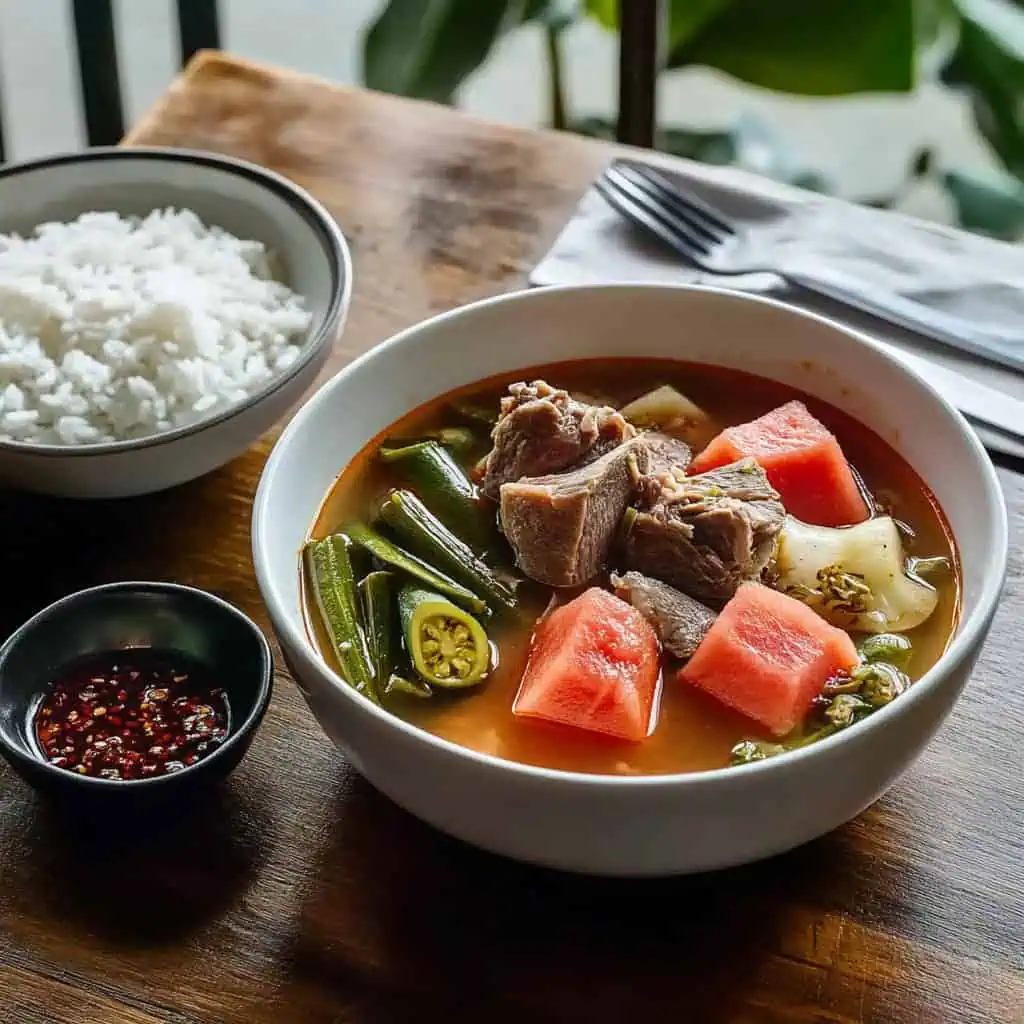
Why You'll Love This Recipe
This innovative take on traditional sinigang combines the classic sour tamarind base with the natural sweetness of watermelon, creating a perfectly balanced flavor profile. The slow-cooked beef becomes exceptionally tender while absorbing the complex flavors of aromatics and fruits, making each spoonful a delightful experience of sweet, sour, and savory notes.
Ingredients
Each component in this recipe serves a specific purpose in creating the perfect balance of flavors and textures. Beef brisket provides rich, hearty protein that becomes tender through slow cooking.
Watermelon adds natural sweetness that counterbalances the sour tamarind. Taro roots add starchy thickness to the broth, while fresh vegetables like okra and kangkong contribute contrasting textures. The aromatics (onion, ginger, lemongrass) create a fragrant base, while chilies add gentle heat.
This thoughtful combination creates a complex soup where every ingredient enhances the others.

- 1 kg beef brisket, cut into 2-inch cubes
- 1 large seedless watermelon, peeled and cubed
- 8-10 small taro roots (gabi), peeled
- 12-15 okra
- 1 bunch water spinach (kangkong), trimmed
- 1 large white onion, cut into wedges
- 1 thumb-sized ginger, thinly sliced
- 2 stalks lemongrass (white part only), bruised
- 4 green finger chilies (siling haba)
- 40g packet sinigang mix OR 400g fresh tamarind
- Fish sauce (patis) to taste
- Freshly ground black pepper
- Water for cooking
Equipment
- Large Heavy-Bottom Pot (Kaldero) - Provides even heat distribution during the extended cooking time, essential for properly tenderizing the beef
- Sharp Knife and Cutting Board - For preparing all ingredients efficiently and safely
- Muslin Cloth - Used if preparing with fresh tamarind to easily extract the sour flavor
- Spider Strainer - Helps remove scum during the initial boiling of beef, ensuring a clean-tasting broth
- Measuring Cups and Spoons - For precise ingredient measurements
- Large Serving Bowl - For presenting the finished dish beautifully
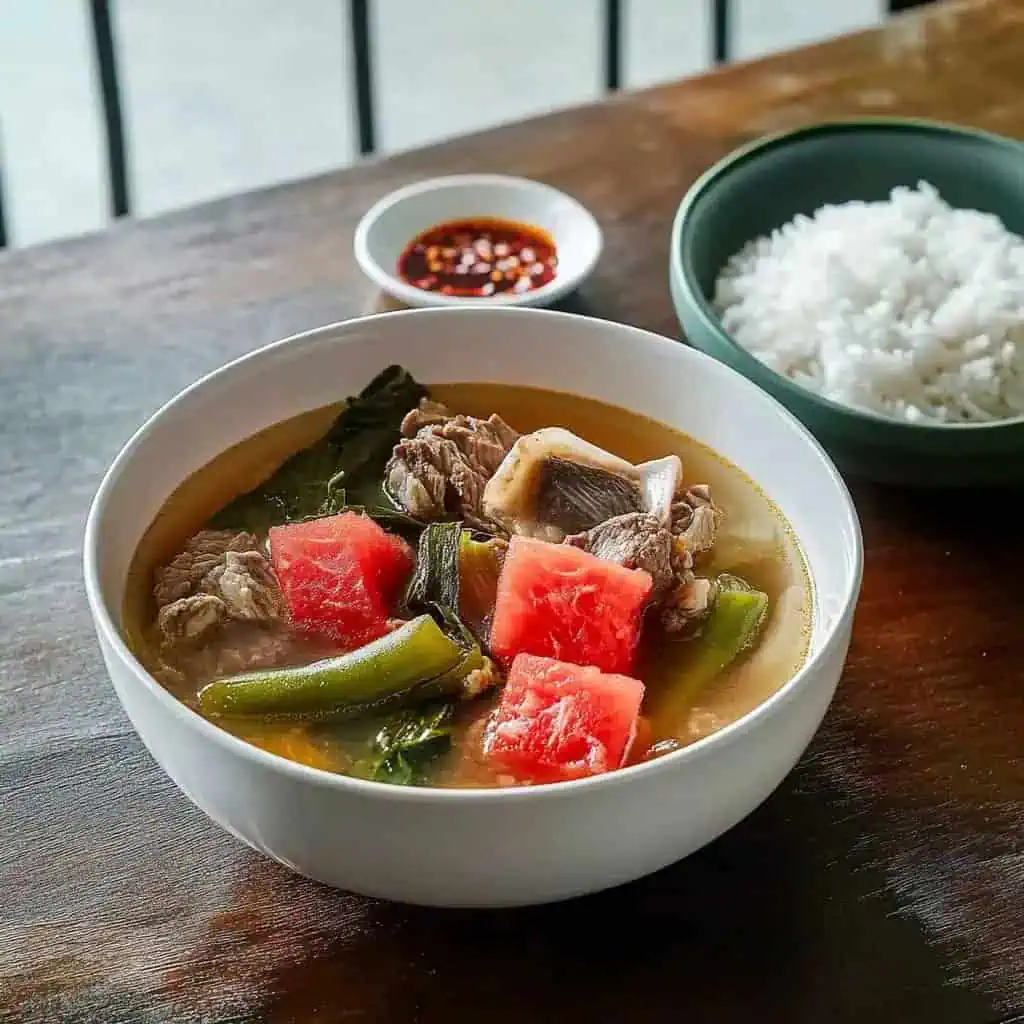
How To Make
- Prepare all ingredients. Cut beef into 2-inch cubes, peel and clean taro roots, cut onions into wedges, bruise lemongrass stalks by pounding them lightly, and separate kangkong leaves from stalks. Cut watermelon into 1-inch cubes and set aside.
- Parboil the beef. Fill a large pot with water and place beef inside. Bring to a boil and cook for 10 minutes to remove impurities. Drain the beef and rinse under running water until clean. This step ensures a clear, clean-tasting broth.
- Layer ingredients for optimal flavor infusion. In a clean large pot, arrange watermelon cubes in a single layer at the bottom. Place the cleaned beef on top of the watermelon layer. Add onion wedges, ginger slices, and bruised lemongrass. If using fresh tamarind, wrap it in muslin cloth and tie ends securely. Add water just enough to cover everything.
- Begin the slow cooking process. Bring to a boil, then lower heat to maintain a gentle simmer. Cook for 1 hour, allowing the beef to become tender and the watermelon to infuse the broth with sweetness.
- Add taro for natural thickening. Add the peeled taro roots and continue simmering for 30 minutes until they're tender when pierced with a fork. The taro will help thicken the broth naturally.
- Introduce the sour element. Add the sinigang mix or, if using fresh tamarind, squeeze the muslin bag several times to extract all the juice. Remove and discard the lemongrass stalks. Taste and adjust sourness according to your preference.
- Cook the vegetables properly. Add green chilies and okra. Cook for 5 minutes until the okra is just tender but still bright green. Don't overcook the vegetables to maintain their texture.
- Finish with delicate greens. Add kangkong leaves, cover the pot, and turn off the heat immediately. The residual heat will cook the greens perfectly while keeping them crisp.
- Season to perfection. Season with freshly ground black pepper and fish sauce to taste. Let the soup rest for 5 minutes before serving to allow flavors to settle.
- Serve properly. Serve hot in individual bowls alongside steaming white rice. Prepare small dishes of fish sauce and sliced chilies as condiments, allowing everyone to adjust flavors to their liking.

Tips from Lola's Kitchen
- Select the right watermelon: Choose slightly underripe watermelon for better texture in the soup as it holds its shape better during cooking
- Maximize aromatics: Bruise lemongrass well by pounding it with the back of a knife to release maximum flavor
- Perfect your greens: Add kangkong at the very end and let residual heat cook it to maintain its crisp texture
- Balance your flavors: Taste before adding fish sauce as sinigang mix already contains salt
- Layering technique: The key to success is layering watermelon at the bottom of the pot so its sweetness gradually infuses into the broth
- Scum removal: Continuously skim off any scum that rises to the surface during cooking for a clearer broth
Substitutions
- Meat options: Pork ribs, chicken, or fish can replace beef (adjust cooking time accordingly - pork needs similar time, chicken about 45 minutes, fish only 10-15 minutes)
- Alternative souring agents: Fresh kamias or green mango if tamarind is unavailable
- Vegetable swaps: Substitute radish for taro, pechay for kangkong, string beans for okra
- Aromatics alternatives: Calamansi leaves can replace lemongrass for a different citrus note
- Watermelon substitutes: Honeydew melon works but will provide a different sweetness profile
Troubleshooting
- Tough beef issue: If beef remains tough, extend simmering time by 30-minute intervals until tender. Quality brisket requires patience to break down properly.
- Overly sour broth: Add more watermelon cubes or a teaspoon of sugar to balance the acidity. Remember that finding the perfect balance is key.
- Thin broth: Incorporate additional taro, which naturally thickens the soup as it cooks, or simmer uncovered for 15-20 minutes to reduce.
- Watermelon disintegration: Add watermelon in two batches - half for cooking and flavor infusion, half during the final 5 minutes for texture and visual appeal.
- Vegetables overcooked: Add firmer vegetables like okra and taro earlier, and delicate ones like kangkong at the very end with the heat turned off.
Storage & Reheating
Storage:
- Refrigerate in an airtight container for up to 3 days.
- Freeze for up to 1 month (exclude kangkong and add fresh when reheating).
- Store broth and solids separately for best results if planning to keep for several days.
Reheating:
- Warm on stovetop over medium heat until just simmering - avoid rapid boiling.
- Add a splash of water if the broth has thickened too much in storage.
- Add fresh kangkong when reheating for the best texture.
- If frozen, thaw overnight in refrigerator before reheating for even warming.
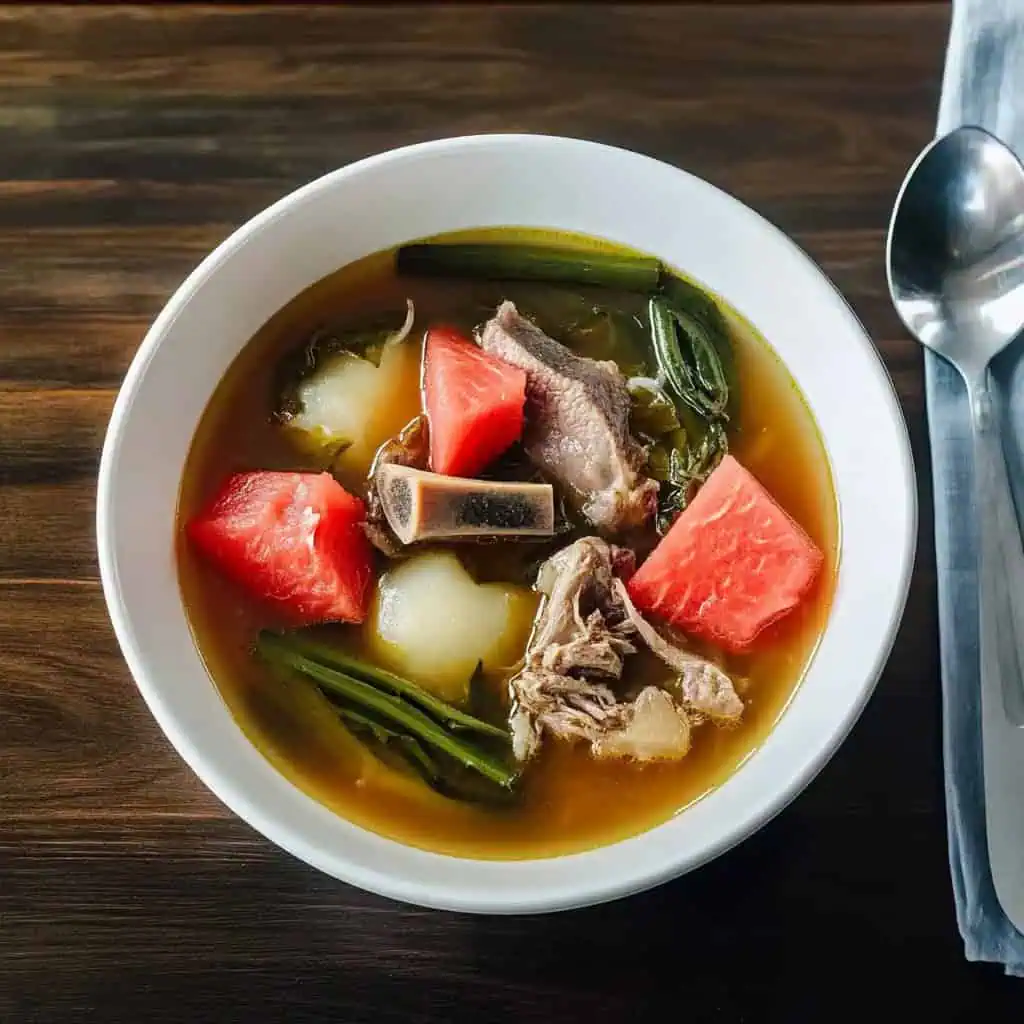
FAQ
Can I make this in advance for a party?
Yes, you can prepare the soup up to the point of adding vegetables. Complete the dish by adding okra, chilies, and kangkong just before serving. This ensures the vegetables maintain their texture and color.
Why does my watermelon dissolve completely?
Add watermelon in stages - use some for flavor during cooking, then add fresh cubes in the last 5 minutes for texture. Also, cutting larger cubes and using slightly underripe watermelon helps it maintain structure.
Is this authentic Filipino cuisine?
This is a modern innovation of traditional sinigang, representing Filipino cuisine's evolution. While not centuries-old, it has become a beloved contemporary interpretation that honors traditional techniques while introducing new flavor combinations.
Can I reduce the cooking time using a pressure cooker?
Yes, pressure cook beef for 30 minutes, then release pressure, add remaining ingredients and proceed with regular instructions. You'll still need to add vegetables after pressure cooking to prevent overcooking them.
How can I make this dish less sour?
Add more watermelon or a small amount of sugar to balance the sourness. You can also use less sinigang mix or tamarind than called for, adding it gradually until you reach your preferred level of sourness.
What makes this version different from traditional sinigang?
The addition of watermelon creates a sweet-sour balance not found in traditional sinigang, which is predominantly sour. This creates a more complex flavor profile while maintaining the dish's essential character.
Related
Looking for other recipes like this? Try these:
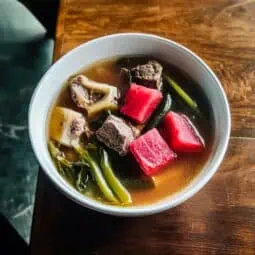
Sinigang sa Pakwan (Watermelon Tamarind Beef Soup)
Equipment
- Large Heavy-Bottom Pot (Kaldero) For even heat distribution during long cooking
- Sharp knife and cutting board (kutsilyo at sangkalan) For preparing ingredients
- Muslin cloth (katsa) If using fresh tamarind
- Spider strainer (sandok) For removing scum during initial boiling
- Measuring cups and spoons (Panukat) For precise ingredients measurements
- Large serving bowl (mangkok)
Ingredients
- 1 kg beef brisket baka, cut into 2-inch cubes
- 1 large seedless watermelon pakwan, peeled and cubed
- 8-10 pieces small taro gabi, peeled
- 12-15 pieces okra
- 1 bunch water spinach kangkong, trimmed
- 1 large white onion sibuyas, cut into wedges
- 1 thumb-sized ginger luya, thinly sliced
- 2 stalks lemongrass tanglad, white part only, bruised
- 4 pieces green finger chilies siling haba
- 40 g packet sinigang mix OR 400g fresh tamarind sampalok
- Fish sauce patis to taste
- Freshly ground black pepper paminta
- Water for cooking
Instructions
- Begin by preparing all ingredients. Cut beef into 2-inch cubes, peel and clean taro roots, cut onions into wedges, bruise lemongrass stalks by pounding them lightly, and separate kangkong leaves from stalks. Cut watermelon into 1-inch cubes and set aside.
- Fill a large pot with water and place beef inside. Bring to a boil and cook for 10 minutes to remove impurities. Drain the beef and rinse under running water until clean. This step ensures a clear, clean-tasting broth.
- In a clean large pot, arrange watermelon cubes in a single layer at the bottom. Place the cleaned beef on top of the watermelon layer. Add onion wedges, ginger slices, and bruised lemongrass. If using fresh tamarind, wrap it in muslin cloth and tie ends securely. Add water just enough to cover everything.
- Bring to a boil, then lower heat to maintain a gentle simmer. Cook for 1 hour, allowing the beef to become tender and the watermelon to infuse the broth with sweetness.
- Add the peeled taro roots and continue simmering for 30 minutes until they're tender when pierced with a fork. The taro will help thicken the broth naturally.
- Add the sinigang mix or, if using fresh tamarind, squeeze the muslin bag several times to extract all the juice. Remove and discard the lemongrass stalks. Taste and adjust sourness according to your preference.
- Add green chilies and okra. Cook for 5 minutes until the okra is just tender but still bright green. Don't overcook the vegetables to maintain their texture.
- Add kangkong leaves, cover the pot, and turn off the heat immediately. The residual heat will cook the greens perfectly while keeping them crisp.
- Season with freshly ground black pepper and fish sauce to taste. Let the soup rest for 5 minutes before serving to allow flavors to settle.
- Serve hot in individual bowls alongside steaming white rice. Prepare small dishes of fish sauce and sliced chilies as condiments, allowing everyone to adjust flavors to their liking.
Tips from Lola's Kitchen
- Choose slightly underripe watermelon for better texture in the soup
- Bruise lemongrass well to release maximum flavor
- Don't overcook the kangkong to maintain its crisp texture
- Taste before adding fish sauce as sinigang mix contains salt
Nutrition
The Story Behind Sinigang sa Pakwan
Sinigang sa Pakwan represents the innovative spirit of modern Filipino cuisine while honoring our deeply rooted culinary traditions. This unique variation of the classic sour soup emerged in the contemporary dining scene of Metro Manila, with restaurants like Manam popularizing this creative interpretation that has since captured the hearts of Filipino food enthusiasts.
Traditional sinigang, a dish that predates Spanish colonization, has always been characterized by its distinctive sourness, typically achieved through tamarind (sampalok). Historical records suggest that our ancestors have been preparing this sour soup since pre-colonial times, using various souring agents native to different regions of the Philippines. The dish has continuously evolved, adapting to local ingredients and changing tastes across generations.
The addition of watermelon to sinigang exemplifies the modern Filipino chef's approach to culinary innovation. This contemporary twist was first popularized in urban Filipino restaurants around 2015, with Manam's version becoming particularly celebrated for its perfect balance of sour and sweet notes. The restaurant's interpretation demonstrated how traditional dishes could be reimagined while maintaining their essential character.
What makes this variation particularly interesting is how it builds upon a growing trend in Filipino cuisine of incorporating fruit into traditionally savory dishes. Similar to how strawberry has found its way into sinigang, or how pineapple enriches menudo, watermelon's addition showcases our cuisine's openness to creative combinations. The natural sweetness of watermelon doesn't just complement the soup's sourness; it actually enhances the overall flavor profile, making the broth more complex and nuanced.
Food historians note that this evolution mirrors broader trends in Southeast Asian cuisine, where the interplay of sweet and sour flavors has long been celebrated. Similar combinations can be found in Thai Tom Yum, Vietnamese Canh Chua, and Malaysian Asam Pedas, suggesting a regional palate that appreciates this balance of tastes. However, Sinigang sa Pakwan stands out for its uniquely Filipino interpretation of these flavor principles.
Today, this innovative dish has moved beyond restaurant menus to become a beloved variation in Filipino homes, representing how traditional recipes can successfully evolve to embrace contemporary tastes while maintaining their cultural significance. It serves as a perfect example of how Filipino cuisine continues to grow and adapt while staying true to its roots.
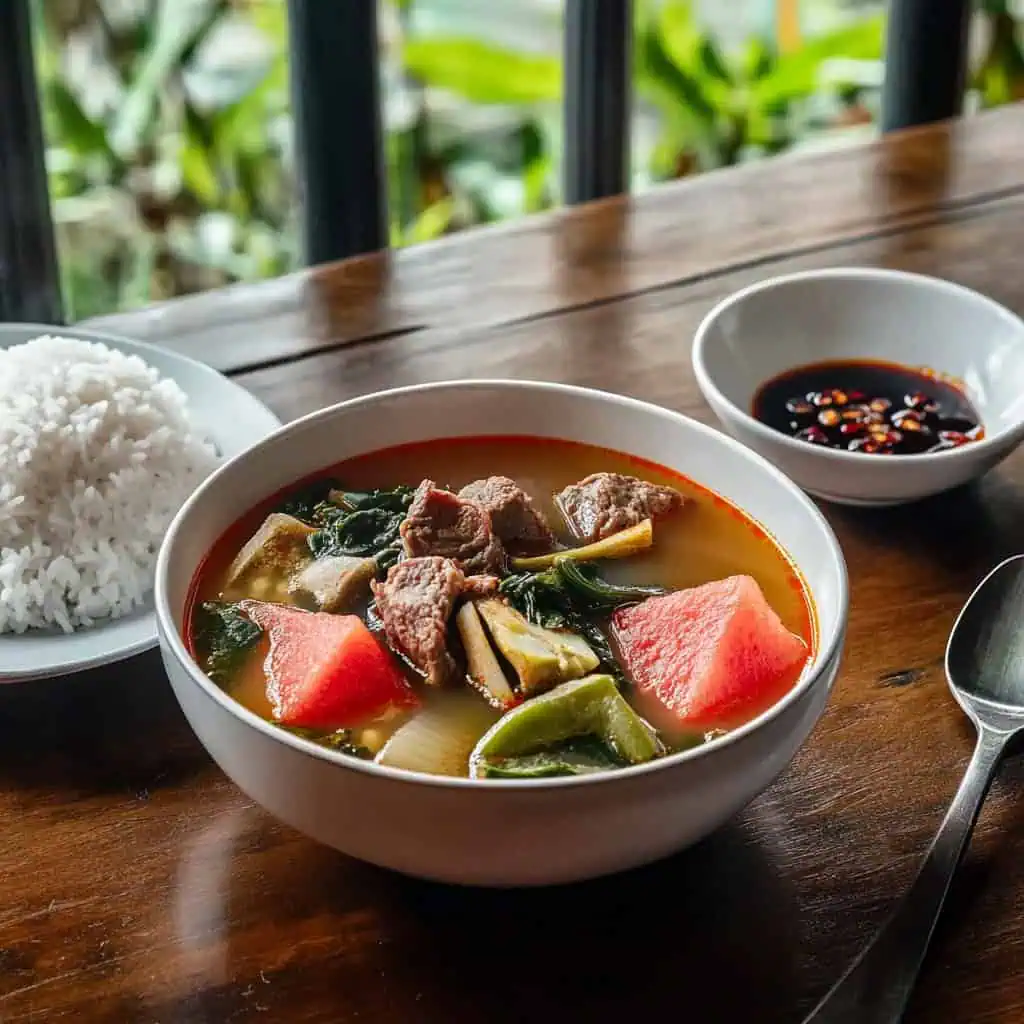




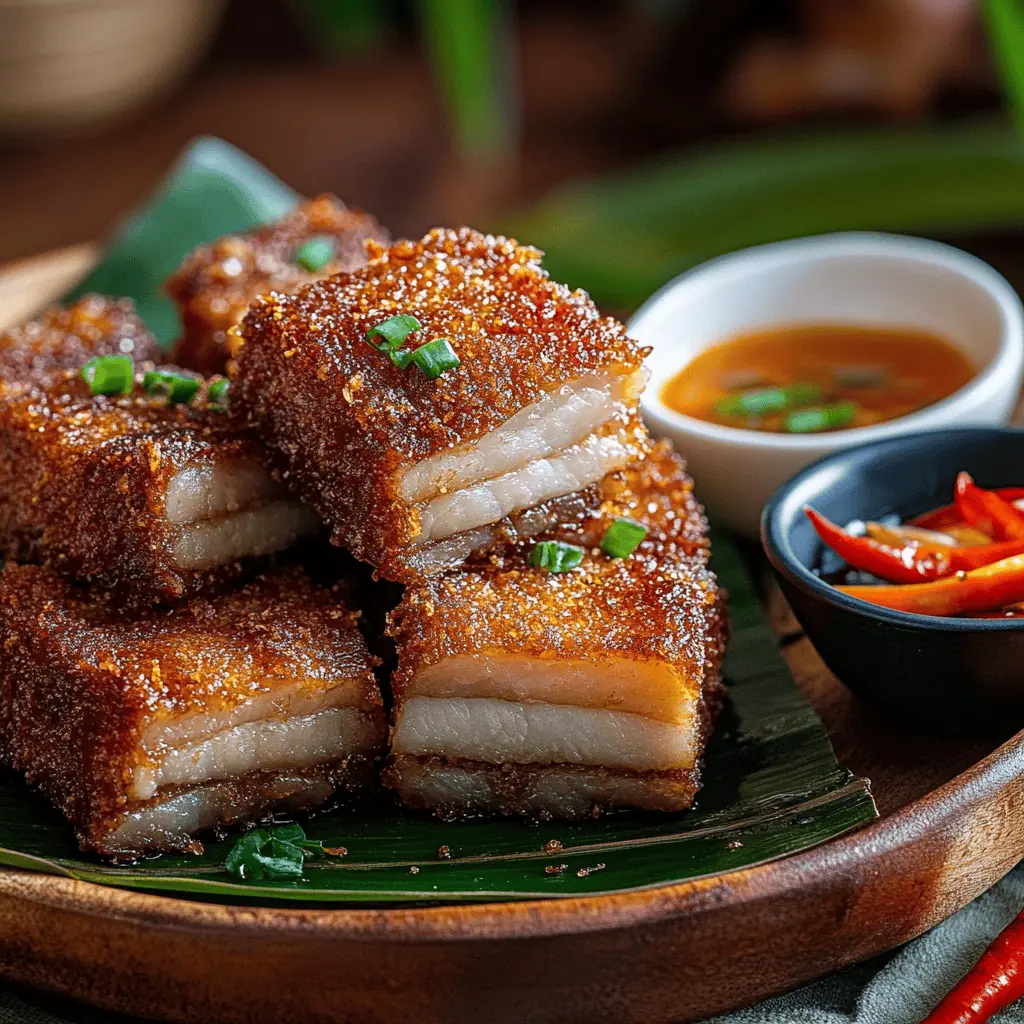



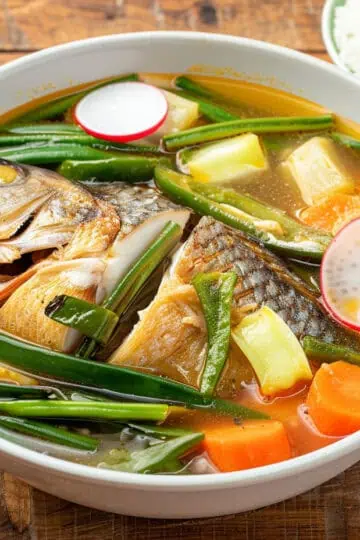
Comments
No Comments